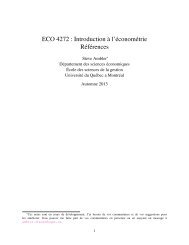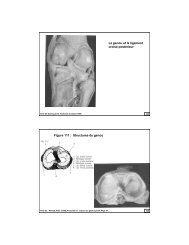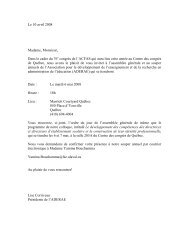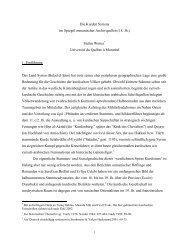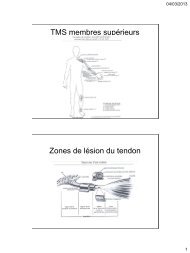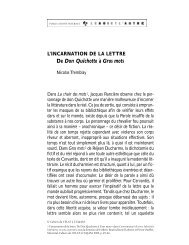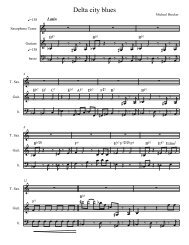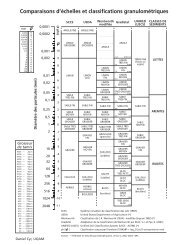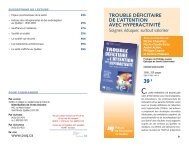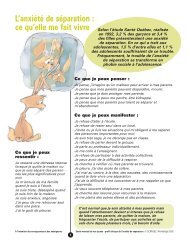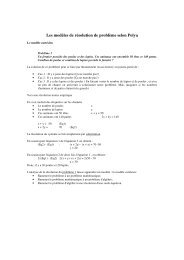Télécharger la revue en format "pdf". - UQAM
Télécharger la revue en format "pdf". - UQAM
Télécharger la revue en format "pdf". - UQAM
Create successful ePaper yourself
Turn your PDF publications into a flip-book with our unique Google optimized e-Paper software.
Perceptions of persona! risk from sexua! transmission of H!V 49<br />
J'ai confiance <strong>en</strong> lui, <strong>en</strong> ce qu'il me dit. Peut-être qu'il ne me dit pas <strong>la</strong><br />
vérité, mais j'ai tout de même confiance que c'est <strong>la</strong> vérité.<br />
The consequ<strong>en</strong>ce was that wom<strong>en</strong> relied on trust rather than<br />
condoms for self-protection.<br />
Unlike wom<strong>en</strong>, m<strong>en</strong> did not describe any difficulties in introducing<br />
condoms into coital partnerships. Most m<strong>en</strong> described using condoms<br />
in virtually all new partnerships:<br />
1 use condoms at first, until 1 get to know a girl, until 1 can trust her and<br />
know something about her past.<br />
Ev<strong>en</strong> wh<strong>en</strong> the partnership became a re<strong>la</strong>tionship and the female<br />
partner was using oral contraception, if a man doubted his partner's<br />
past, he used condoms. Thus, for m<strong>en</strong>, in interviews as in surveys,<br />
re<strong>la</strong>tionship status was not the key factor influ<strong>en</strong>cing their perception<br />
of susceptibility, or their risk reducing actions, instead, the exist<strong>en</strong>ce of<br />
cues which alerted them to the possibility that their partner might be<br />
infecte d, were the primary influ<strong>en</strong>ces.<br />
DISCUSSION<br />
Survey and interview results suggested that both cues and<br />
judgm<strong>en</strong>tal heuristics influ<strong>en</strong>ced risk perception, though somewhat<br />
differ<strong>en</strong>tly for m<strong>en</strong> than for wom<strong>en</strong>. The results further suggested<br />
ways in which judgm<strong>en</strong>tal heuristics could be integrated into the<br />
Health Belief Model for a more compreh<strong>en</strong>sive understanding of the<br />
developm<strong>en</strong>t of risk perception.<br />
In the Health Belief Mode! risk perception is influ<strong>en</strong>ced by cues and<br />
by a feedback effect from prev<strong>en</strong>tive action. The former was evid<strong>en</strong>t<br />
in the analysis of survey responses in the influ<strong>en</strong>ce of contact with<br />
fri<strong>en</strong>ds who had be<strong>en</strong> tested for HIV and having had more than one<br />
coital partner. This re<strong>la</strong>tionship held for both m<strong>en</strong> and wom<strong>en</strong>.<br />
Interviewees e<strong>la</strong>borated on the feedback from action to perception, in<br />
their daims that the prev<strong>en</strong>tive actions they were taking (particu<strong>la</strong>rly<br />
careful partner selection, a prefer<strong>en</strong>ce for re<strong>la</strong>tionship-based sex and,<br />
primarily for m<strong>en</strong>, a selective use of condoms) were providing them<br />
with effective protection and that they were consequ<strong>en</strong>tly at low risk<br />
for infection. Judgm<strong>en</strong>tal heuristics operated in the interpretation of<br />
cues and actions, with the interpreted cues and actions th<strong>en</strong><br />
influ<strong>en</strong>cing risk perception. The repres<strong>en</strong>tativ<strong>en</strong>ess heu ris tic made it<br />
possible for young adults to believe they could select "safe", i.e. non<br />
infected, partners since it fostered the belief that only certain types of<br />
people were likely to be infected and that one was less likely to



